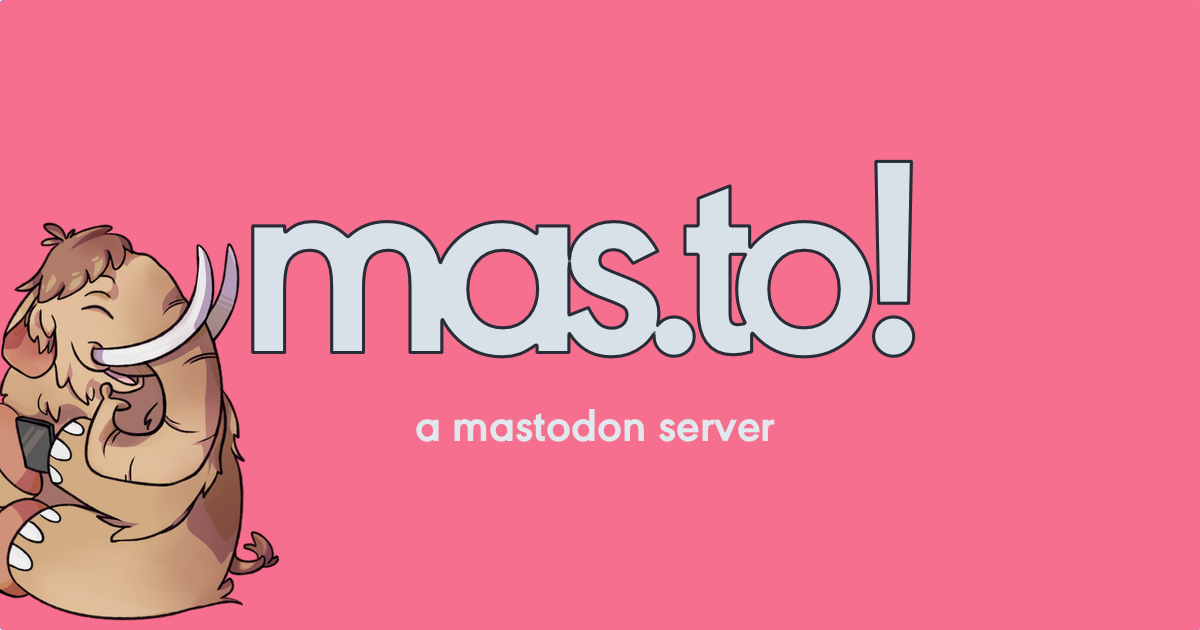Recent searches
Search options
But that is BAD, VERY BAD! So the Fediverse is split into a myriad platforms -- and hence communities -- with incompatible features.
That may be great for the computer nerds who will join a dozen platforms just to revel in the features. It is terrible for those who only want a platform to communicate with other people...
@JorgeStolfi @jupiter_rowland Nope, you got it wrong. Hint: count the number of characters in the toot you just replied to—it's well over 500, because it didn't originate on a Mastodon server! It's a federated system, so every client can read stuff posted on any other server that supports ActivityPub. (Imagine you could read Twitter tweets on your Facebook page. Only more so.) If all you want to do is to toot, that's fine—everyone else can see you just fine.
But what happens when a message with fancy formatting/threading/etc is read by someone from a server that does not support such features?
@JorgeStolfi @jupiter_rowland The message gets transmitted to the client, whose reader is then responsible for displaying/formatting that message (or not, if it lacks the capability). This isn't new. It's how the internet worked 20 years ago, before all these gigantic corporate silos took over. (I shouldn't need to explain this to you, should I …? Graceful degradation of capabilities isn't an new requirement …)
But that is my point. Email and Usenet had a standard message format (ascii text, unfortunately, because that was before Unicode). Every valid server was supposed to issue only compliant messages and properly display any compliant message. This does not seem to be the case in the Fediverse, is it?
@JorgeStolfi @jupiter_rowland Think back to the early web, when a browser like Mosaic didn't support just http: but also ftp: gopher: nntp: and other protocols. The message formatting was implicit in the protocol used. And worse: different browsers implemented different versions of HTML.
It strikes me as weird that we're able to have this discussion on a number of different federated ActivityPub servers, using a growing variety of front-ends, and still there are people complaining that it's not working as well as it should, because reasons.
I still don't know what I'm supposed to make of fact that some people don't know the difference between Mastodon and Hubzilla. Well if it comes to that, they don't need to know. It all works just fine anyway, as long as you can grasp that users are identified by at username at instance instead of at username.
@bitnik @jupiter_rowland @cstross
Are we indeed able to dicuss Fediverse-wide? Or just among those who use a particular prootcol (ActivityPub?)?
And even within the latter, there seem to be obvious problems. I don't see any markups in other people's messages (e.g. cant tell block quotes from the sender's own text). And I am limited to 500 byte posts, so I cannot quote 1000 chars from a post that someone else sent me.
Yes, it's ActivityPub (which is the only universally supported protocol that can really be said to define the fediverse) and if you want you can chain smaller posts together, or post a link to the text you're referring to.
As for markup, we managed just fine in 7-bit ascii on Usenet, no markup conventions.
@bitnik @jupiter_rowland @cstross
The problem is not whether the character set and markup should be richer or poorer, it is standardization.
I guess that I am asking for an "RFC" of the ActivityPub protocol AND of the markup conventions. So that every conforming server is allowed to issue any but only posts that will be properly and faithfully presented in any other conforming server.
While that's a nice-to-have, I don't see markup as a priority. There is a more or less settled standard for ActivityPub managed by a working group within W3C:
https://www.w3.org/TR/activitypub/
@bitnik @jupiter_rowland @cstross
The original HTTP format was meant to encode the linguistic information of a document, not its looks. Thus it had section headers, bullet lists, paragraph breaks, italics, and boldface, for the same reason that it had upper and lower case letters: because those attributes affect the meaning of the text, not just its appearance. >>
@bitnik @jupiter_rowland @cstross
>> On the other hand, the early HTML did not specify line breaks or fonts, because those attributes were basically looks, and had better be chosen by the reader according to his display size and environment.
The Fediverse could adopt the same philosophy: yes to semantically relevant markup like italic and boldface, but no font selection or physical layout. So that readers can get the same information from a message, no matter what reading app they use.
@JorgeStolfi @bitnik @jupiter_rowland HTTP is a transport protocol. You're talking about HTML, which was a specialized subset of SGML, a semantic markup language.
@cstross @bitnik @jupiter_rowland
Right, of course. Sorry.




